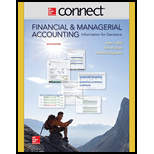
1.
To identify:
Total amount of cash and cash equivalents and its percentage in reference of total current assets, total current liabilities, total shareholder’s equity and total assets for 2012 and 2013.
1.
Explanation of Solution
Balance of cash and cash equivalents as on September 28, 2013 and September 29, 2015 are as follows:
| Particulars | Balance as on September 28, 2013 ($) |
% of cash and cash equivalents (%) |
Balance as on September 29, 2012 ($) |
% of cash and cash equivalents (%) |
|---|---|---|---|---|
| Cash and its equivalents | 14,259 | 10,746 | ||
| Current Assets | 73,286 | 19.5 |
57,653 | 18.6 |
| Current Liabilities | 43,658 | 32.7 |
38,542 | 27.9 |
| Shareholder’s Equity | 123,549 | 11.5 |
118,210 | 9.1 |
| Net Assets | 207,000 | 6.9 |
176,064 | 6.1 |
Table (1)
Review of trend:
From above data, it is observed that cash and cash equivalents have increased in 2013 as compared to 2012.
Hence, it is ascertained that liquidity position of A Company has increased slightly as compared to last year.
2.
Cash and cash equivalents percentage change in the beginning and ending of the year through the information contained in
2.
Explanation of Solution
Formula to calculate the percentage change in cash and cash equivalents is:
2013
Given,
Cash and cash equivalents in the beginning of 2013 is $10,746 million.
Cash and cash equivalents at the end of the year is $14,259 million.
Substitute $10,746 million for cash and cash equivalents in the beginning of the 2015 and $14,259 million at the end of the year,
Hence, percentage change represents an increase of 24.6%.
2014
Given,
Cash and cash equivalents in the beginning of 2014 is $9,815 million.
Cash and cash equivalents at the end of the year is $10,746 million.
Substitute $9,815 million for cash and cash equivalents in the beginning of the 2015 and $10,746 million at the end of the year,
Hence, percentage change represents a decrease of 8.7%.
3.
Day’s sales uncollected as of September 28, 2013 and September 29, 2012.
3.
Explanation of Solution
Day’s sales uncollected imply how much days a company takes to collect its accounts receivables.
Formula to calculate day’s sales uncollected is:
2013
Given,
Net sales are $170,910 million.
Substitute $13,102 million for accounts receivable, and $170,910 million for net sales,
2012
Given,
Accounts receivable is $10,930 million.
Net sales are $156,508 million.
Substitute $10,930 million for accounts receivable, and $156,508 million for net sales,
Hence, day’s sales uncollected are accounted for 2013 is 28 days and for 2012 is 25.48 days.
• Thus, it is concluded that A Company has declined its performance in order to collect its receivable as now it would take 2.52 more days to collect receivables.
• Accounts receivables are important part of the company as it indicates about the turnover. So, company should take steps for its improvements.
4.
Day’s sales uncollected as of September 26, 2015.
4.
Explanation of Solution
Day’s sales uncollected imply how much days a company takes to collect its accounts receivables.
Given info,
Accounts receivable is $16,849 million.
Net sales are $233,715 million.
Formula to calculate day’s sales uncollected is,
Substitute $16,849 million for accounts receivable and $233,715 million for net sales,
Hence, day’s sales uncollected are accounted for 26.31 days.
Thus, company would take 1.69 days more days to collect its receivables in the year 2013 (28 days) as compared to 2015 (26.31 days).
Want to see more full solutions like this?
Chapter 6 Solutions
Connect 2 Semester Access Card for Financial and Managerial Accounting
- Can you please help me by providing clear neat organized answers. Thank you!arrow_forwardSummary: You will investigate a case of asset theft involving several fraudsters for this assignment. The case offers a chance to assess an organization's corporate governance, fraud prevention, and risk factors. Get ready: Moha Computer Services Limited Links to an external website: Finish the media activity. The scenario you need to finish the assignment is provided by this media activity. Directions: Make a four to five-page paper that covers the following topics. Management must be questioned by an auditor regarding the efficacy of internal controls and the potential for fraud. A number of warning signs point to the potential for fraud in this instance. List at least three red flags (risk factors for fraud) that apply to the Moha case. Sort them into three groups: opportunities, pressures/incentives, and (ethical) attitudes/justifications. Determine which people and organizations were impacted by Moha Computer Services Limited's enormous scam. Describe the fraud's financial and…arrow_forwardCoarrow_forward
- Critically assess the role of the Conceptual Framework in financial reporting and its influence onaccounting theory and practice. Discuss how the qualitative characteristics outlined in theConceptual Framework enhance financial reporting and contribute to decision-usefulness. Provideexamples to support your analysis.arrow_forwardCritically analyse the role of financial reporting in investment decision-making,emphasizing the qualitative characteristics that enhance the usefulness of financialstatements. Discuss how financial reporting influences both investor confidence andregulatory decisions, using relevant examples.arrow_forwardHelp need!!arrow_forward

 AccountingAccountingISBN:9781337272094Author:WARREN, Carl S., Reeve, James M., Duchac, Jonathan E.Publisher:Cengage Learning,
AccountingAccountingISBN:9781337272094Author:WARREN, Carl S., Reeve, James M., Duchac, Jonathan E.Publisher:Cengage Learning, Accounting Information SystemsAccountingISBN:9781337619202Author:Hall, James A.Publisher:Cengage Learning,
Accounting Information SystemsAccountingISBN:9781337619202Author:Hall, James A.Publisher:Cengage Learning, Horngren's Cost Accounting: A Managerial Emphasis...AccountingISBN:9780134475585Author:Srikant M. Datar, Madhav V. RajanPublisher:PEARSON
Horngren's Cost Accounting: A Managerial Emphasis...AccountingISBN:9780134475585Author:Srikant M. Datar, Madhav V. RajanPublisher:PEARSON Intermediate AccountingAccountingISBN:9781259722660Author:J. David Spiceland, Mark W. Nelson, Wayne M ThomasPublisher:McGraw-Hill Education
Intermediate AccountingAccountingISBN:9781259722660Author:J. David Spiceland, Mark W. Nelson, Wayne M ThomasPublisher:McGraw-Hill Education Financial and Managerial AccountingAccountingISBN:9781259726705Author:John J Wild, Ken W. Shaw, Barbara Chiappetta Fundamental Accounting PrinciplesPublisher:McGraw-Hill Education
Financial and Managerial AccountingAccountingISBN:9781259726705Author:John J Wild, Ken W. Shaw, Barbara Chiappetta Fundamental Accounting PrinciplesPublisher:McGraw-Hill Education





